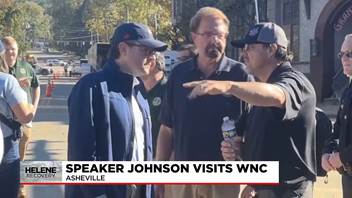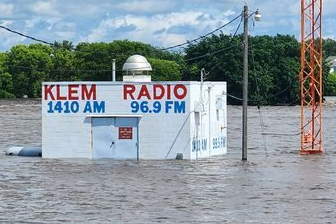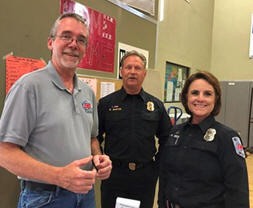| Radio Is the Default During Disasters | | Storms Helene and Milton Underlined the Medium's Importance to Congress |  | | Speaker Mike Johnson talks with storm survivors in Asheville, NC. | | Courtesy of Alexa Erbach, Fox Carolina News | WASHINGTON DC House Speaker Mike Johnson (R-LA) just saw an “up close and personal” demonstration in Florida, Georgia and North Carolina of how the radio medium is uniquely positioned to save lives and property in large-scale emergencies. He hardly needed a reminder, hailing from the state harassed by Hurricane Katrina in 2005. Johnson called this October's devastation some of the worst he has ever seen, "and that's saying a lot," he commented. “I, and so many others, can attest to the importance of AM radio at a time like this to get critical information to people in a way they can access like no other…”
Though poised to pass in both houses of Congress, the “AM Radio for In Every Vehicle Act” must be voted on soon, or it will require reintroduction in the next session. Johnson is the man to make that happen in the House. [Text “AM” to 52886 to join the NAB’s campaign to keep this lifesaving legislation moving.] The Act mandates that AM receivers reside in the dashboards of all cars sold in the US because of AM's unique ability to reach 90% of Americans. |  | | Storm-damaged roads hamper recovery after Hurricanes Helene & Milton. | | Johnson heard stories from radio owners, announcers and engineers who had waded into the fray for their communities. They get no better than that of WWNC in Western North Carolina, which transformed itself into a personal bulletin board and dispatch service for the Asheville area during the height of the storm, when power and cellphone service went south. Thankful residents dubbed the station “The Best Magaphone in Western North Carolina.” [See the 3-minute video "How radio was a lifeline for North Carolina residents during, after Helene (youtube.com)," 7News, WSPA.com, Oct. 14, 2024.] |
|  | | Low Power Lifeline | | Powell Broadcasting Drops Power 99% During Flooding; Still Covers City of License | LE MARS, IA KLEM Radio is a legend in the "Siouxs." Its 1000-watt AM signal is heard from Sioux City, Iowa, to Sioux Falls, South Dakota. Both their AM signal on 1410 and their translator on 96.9 FM are critcal to the local population for safety information. But when torrential rain came down in June and waters rose at the AM transmitter site, engineers needed to get KLEM-AM back on air fast so their FM signal could remain viable. The solution was to rent an immediately- available 10-watt AM transmitter to plug in while theirs underwent repair. Yes, 10 watts is only 1% of the radio station’s 1000-watt FCC-allowed power.
General Manager Dennis Bullock reached out on a Friday to Information Station Specialists, which was able to ship a TR.6000 10-watt transmitter the same day for Saturday delivery. “We quickly got it mounted in the rack and were broadcasting. The coverage in all directions exceeded our expectations, a good signal for nearly 25 miles,” recalls Bullock. “There were high-fives all around when 1410 AM came back to life.”
The company’s “AMReady” page features low-power components calibrated to affordably maintain AM operations when the unanticipated becomes reality. |
|
|  | | Left to Right: Bill Tell of Mile High Radio Cub with Representatives of Riverside County Emergency Services | | California County Adds More 10-Watt Emergency Radio Stations | IDYLLWILD, CA The crew at the Idyllwild Fire Protection District envisioned it decades ago: the concept they pioneered with 10-watt “WNKI-578” Radio on 1610 AM at Idyllwild would be expanded to cover more of the surrounding San Jacinto Mountains south of Palm Springs. Why? Wildfire presents a constant danger to all residents of Riverside County. Add to that, the San Andreas and other fault lines zigzag through the valleys that border to the north and south. Then there’s the hazardous weather that can descend suddenly on that huddle of mountain top communities, stranding drivers.
Now, the Riverside County Office of Emergency Management is adding three more of the 10-watt stations to provide safety information to motorists when it counts. The stations will utilize the high-efficiency HPR.0990 Antenna System to maximize coverage, designed to work in conjunction with the Genasys Outdoor Warning System, which will be installed at 40+ locations in the next phase. The stations will be the first in the nation to be programmed via satellite.
Observes Bill Tell with the local Mile High [HAM] Radio Club, “On this mountain, we have the potential for complete isolation, as we experienced during major road washouts recently, severing our ability to freely commute in and out. With the possibility of wind events or power being turned off during peak fire season, communications have become very critical throughout our region for safety and possible evacuations. Station WNKI 578 proved its worth during the Cranston Fire of 2018. It never ceased to operate, even when power was shut off to our community for several days.”
The power of AM radio – beit only 10 watts of power – elicits high praise in the San Jacinto Mountains. |
| 
ESPN Flagged for Flagrant Violation | WASHINGTON DC On the 17th of October, the FCC proposed a fine of $146,976.00 for the ESPN network for the broadcast of EAS (Emergency Alert System) tones as part of a NBA promotional spot that aired on the network six times in 2023. In a publicly released letter, the Commission pointed out to ESPN that “the use of simulated or actual EAS tones for non-authorized purposes – such as commercial or entertainment purposes – can lead to ‘alert fatigue’ – causing the public to become desensitized to the alerts …" – not to mention possible “false activations” of EAS equipment leading to the spread of “false information.”
The Source applauds the Commission for this overdue action. There is way too much false information being broadcast already this election year. |
|
|
© 1983-2026 • Information Station Specialists, Inc. • All Rights Reserved
PO Box 51, Zeeland, Michigan, USA, 49464-0051, Phone 616.772.2300, Email
• • •
|
| Information Radio Stations is a generic term synonymous with Travelers Information Stations (TIS), Highway Advisory Radio Stations (HAR) / Highway Information Systems & Low Power Radio Stations (LPR). Operation of the stations is governed by FCC Part 90.242 Rules. A FCC license is required. Information Radio Stations may be fixed or portable. Subcomponents may include transmitter, antenna and ground system, digital voice player, wattmeter, cabinet with conventional or Corbin locks, lightning arrestors for RF, power and telephone lines, coaxial cable. Most stations employ black maximized antennas to discourage ice accumulation and security measures to prevent unauthorized program access. Options include synchronization, battery backup, solar power, remote programming by local, network or telco, multi-station audio distribution via RF or LAN / WAN or wireless network. |

